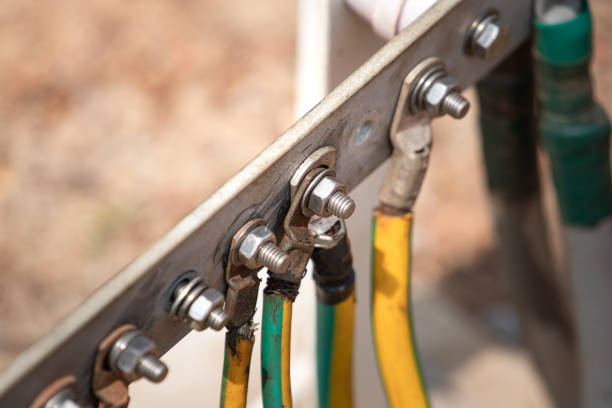Earthing is a fundamental component of electrical safety, providing a path for fault currents to safely dissipate into the ground. This helps protect people and equipment from electrical hazards. Effective earthing practices demand thorough training, appropriate personal protective equipment, and strict adherence to safety procedures, all of which contribute to the safety of workers and the public.
Ground Resistance Testing Techniques
Ground resistance testing is essential for verifying the effectiveness of earthing systems. Various methods are used, each suited to different applications:
- Fall-of-Potential Method (Three-Point Method): A common technique that involves placing two auxiliary electrodes at specific distances from the ground electrode under test. By measuring the voltage drop between the electrodes, resistance can be calculated using Ohm’s law.
- Stakeless Testing: This method uses a clamp-on meter to assess the resistance of grounding systems without additional electrodes, making it ideal for urban settings where placing stakes may be impractical.
- Selective Earth Ground Testing: Combining clamp-on technology with stake testing, this method allows testing of individual ground rods within a parallel-connected system without disconnecting them.
- Soil Resistivity Testing (Wenner Method): Using four equally spaced electrodes, this method measures soil resistivity, a critical factor in designing effective grounding systems.
- Two-Point Method (Dead Earth): This simpler method measures resistance between a grounding electrode and a known reference ground, suitable for quick checks in some conditions.
When performing these tests, factors like soil composition, moisture content, and temperature should be considered, as they can affect resistance measurements. Ground enhancement materials or conductive concrete can improve grounding effectiveness by reducing resistance around electrodes. Regular testing and maintenance of grounding systems are essential to maintain optimal electrical resistance levels.
Equipotential Bonding Practices
Equipotential bonding minimizes the risk of electric shock by ensuring that all conductive parts in a system share the same electrical potential. This practice complements earthing systems, providing additional safety.
Equipotential bonding includes:
- Protective Bonding: Connecting exposed conductive parts of equipment to the main earthing terminal, ensuring that dangerous touch voltages are equalized quickly in fault conditions.
- Functional Bonding: Used to ensure proper equipment operation, particularly in sensitive electronic installations where it minimizes electromagnetic interference.
Bonding conductors are typically installed between various conductive elements in a building, such as metal pipes, structural steel, and ventilation ducts. Equipotential bonding is crucial in high-risk environments like hospitals, where additional bonding may be required to enhance patient safety.
Regular testing of equipotential bonding systems is important for maintaining their effectiveness. By combining proper bonding with earthing systems, overall electrical safety can be significantly improved, protecting both personnel and equipment from potential hazards.
Corrosion-Resistant Earthing Materials
The longevity and effectiveness of earthing systems depend significantly on corrosion-resistant materials:
- Copper: Highly conductive and corrosion-resistant, copper is ideal for earthing applications. However, copper-bonded steel rods offer a cost-effective alternative that balances performance and expense.
- Stainless Steel: Known for exceptional corrosion resistance, stainless steel is suitable for harsh environments, though its higher cost may limit use.
- Zinc-Aluminum Coated Steel: This material has shown excellent corrosion resistance, especially in aggressive soil conditions, making it suitable for challenging environments.
- Galvanized Steel: Although not as corrosion-resistant as other materials, galvanized steel offers a balance of durability and cost-effectiveness.
To further enhance corrosion resistance, additional strategies like using bi-metallic connectors, applying protective coatings, and implementing ground enhancement materials can be employed. Regular inspection and maintenance are vital, as corrosion can impact the performance of earthing systems over time.
Clamp Meter Methodology
Clamp meters allow for safe, efficient current measurements without needing to disconnect the circuit. Based on electromagnetic induction, clamp meters inject a voltage signal into the grounding system or conductor under test and measure the resulting current.
Advantages of clamp meters include:
- Measuring current without circuit interruption, enhancing both safety and efficiency.
- Testing multi-grounded systems in urban areas where traditional stake testing may be challenging.
- Measuring high currents that could damage traditional multimeters.
However, clamp meters measure the total system resistance and may not be ideal for new installations without an established current loop. Their accuracy can be impacted if the resistance of the larger earthing system is comparable to the element being tested. Despite some limitations, clamp meters are a valuable tool for non-intrusive testing of earthing systems.
Soil Resistivity Measurements
Soil resistivity measurements are fundamental in designing grounding systems:
- Wenner Method (Four-Point Method): The most widely used method, it involves placing four electrodes in a straight line at equal distances. A current is injected through the outer electrodes, and the potential difference is measured between the inner electrodes, providing data on soil resistivity.
- Factors Affecting Soil Resistivity: Moisture content, temperature, soil composition, seasonal variations, and dissolved salts all influence soil resistivity and should be considered during testing.
For accurate soil resistivity profiles, measurements should be taken at different depths and locations, often across various seasons, to ensure reliable data. This information helps engineers design effective earthing systems suited to specific site conditions.
By conducting thorough soil resistivity measurements, engineers can design more effective earthing systems that enhance safety and protect electrical installations from faults.
Summary
In summary, effective earthing and bonding practices are essential for electrical safety. Techniques like ground resistance testing, equipotential bonding, and soil resistivity measurement, along with corrosion-resistant materials and advanced tools like clamp meters, contribute to creating reliable grounding systems. These measures protect both people and equipment from electrical hazards, ensuring the long-term stability and safety of electrical installations. Regular testing and maintenance are critical to maintaining optimal performance, especially in diverse environmental conditions.
Keep an eye for more news & updates on Essential Tribune!









